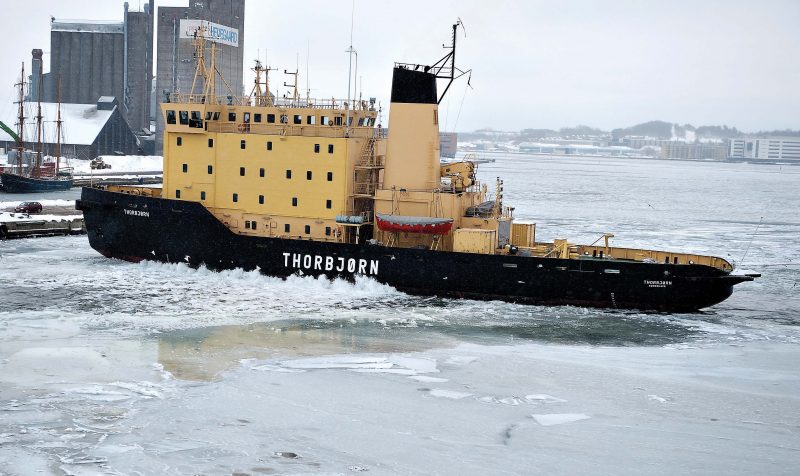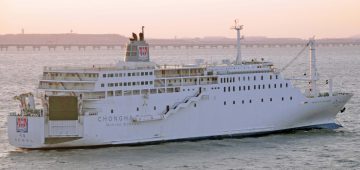
After the turn of 1986/87 the icy winter very quickly lay over the Danish waters and began creating navigation problems for smaller vessels. The state icebreaker Thorbjørn was therefore urgently be staffed, ready to go into active icebreaker service as the first one of four Danish stateowned icebreakers.
On Sunday 11th January 1987, National Ice Services called me and offered me seasonal hire as navigator on Thorbjørn which was at that moment located at the Naval Station at Frederikshavn – if I could begin right NOW. I therefore quickly decided to say yes to this unique opportunity, and around midnight, I arrived at Thorbjørn and was quartered for the night. During the night, and on the next day, the rest of the crew arrived. Many of us had never sailed with an icebreaker before and certainly not Thorbjørn.
The ice layer was thick and strong in the Danish waters, so that day we sailed down to the area around the Hals Barre at the estuary of the Limfjord to assist the shipping industry there.
As time went by, we sailed around the clock to assist shipping anywhere in Danish waters. We seldom had the pilot on board, so it required a good navigator to navigate when the waters markings were turned down by the ice. Back then, we had no GPS.
The ice layer was now so powerful that the other three icebreakers also headed out to help navigation through the ice, and several navigators were now promoted and moved from Thorbjørn to these icebreakers.

On board Thorbjørn it meant that I quickly advanced from third mate to the second mate and then to first mate. There were four watch-keeping navigators on board. Chief Mate and one of the other navigators went on 12-18 and 00-06 duty and the first mate and one of the other navigators went on 06-12 and 18-24 duty. The captain was not on duty, but could always be called for support if he wasn’t in the wheelhouse.
Psychological crisis management on board
As first mate, I was in charge of my shift, together with the third mate to navigate through the ice, and I was in charge of the icebreaker manoeuvres when we assisted ships. Late one evening on my duty we were called up by a northbound ship that was stuck in the ice between Hals Barre and Læsø. I decided immediately to give this ship the first priority on the assistance list and so we sailed to the rescue.
When we arrived at the ship my assessment was that it was not necessary to pull the ship into the icebreaker poop (Klykken) and then tow it on to more navigable waters. It should be enough to sail very close around the ship and then back right up and send our tow wire over so that we could tug her further in this way. In a way, this was a reasonably routine operation, as said, then done, in the dark night with powerful spotlights.
I stood at the back of the wheelhouse and had radio contact with the towed ship while I manoeuvred to keep the tow wire fairly tight and simultaneously kept an appropriate speed ahead through the solid ice. The boatsman on duty stood beside me all the time and helped to adjust the tow wire with a very powerful towing winch while operating the floodlight. The third mate stood in the front of the wheelhouse and navigated and informed back to me if the ice packs were ahead, etc. We were all moving steadily forward, and the ice was not really a big problem, as there were no ice packs on this stretch. Suddenly we were stuck in the ice. There were no ice packs, but instead we had moved into an area with heavy ice thickness which can be difficult to see at the front of the wheelhouse with only spotlights to orient yourself by, sailing the night shift. At the back of the wheelhouse, I did not react quickly enough and in a moment we were stuck. I therefore yelled to the radio contact on the towed ship that he had to turn full speed astern.
It was too late. The towed ship was backing as fast as it could, still keeping a good speed when it turned and hit the ice edge of the broken channel. Then it turned towards us and banged right into our stern. That the towed ship could not really withstand, so it got a big hole in the bow above the waterline. The ship’s captain was somewhat dissatisfied with the situation and shouted on the radio, and our captain was now in the wheelhouse. It had not gone quietly when the second ship hit us.
I never ever forget my captain in those moments. He was perfectly calm, and said to me: “Bjarne, just let him rage on over there. Soon we will give him a good offer. We will tow him to Limfjord so he can proceed on with his voyage and get his ship repaired. I think you should continue on duty and tow him down. Now I will stay a while, and then I will go back to sleep, but as always, you can call me, and I will be there instantly.”

So it was. The rest of the duty and the season passed without more drama. Later, when the situation had calmed, I was told it was not the first time this had happened to the icebreaker, and that it had been even more dramatic on other occasions.

Comments
Sorry, comments are closed for this item